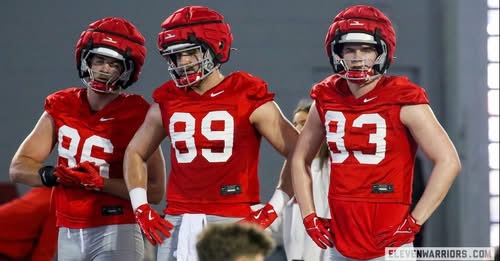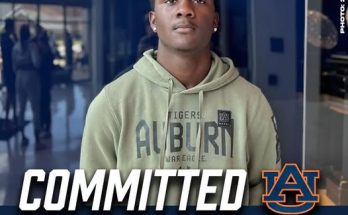The tight end position has always carried a certain mystique in football, often acting as the bridge between offensive linemen and wide receivers. At Ohio State, a program long recognized for its tradition of elite wideouts, quarterbacks, and running backs, the conversation surrounding tight ends has often been overshadowed. Yet, in 2025, the group itself is sending a clear and unapologetic message: they believe they are the strongest position group on the team. It is a bold claim in a program brimming with five-star recruits and NFL-bound talent, but it is one that their confidence, chemistry, and work ethic seem to back up. Within this culture of quiet competitiveness, one name has sparked particular attention—Max Klare. According to teammate Bennett Christian, Klare is the best route-running tight end he has ever seen, and in a football environment where precision in movement often separates starters from role players, that kind of compliment cannot be taken lightly.
What makes Ohio State’s tight ends feel justified in their belief that they are the program’s best collective unit is not only their versatility but also their bond. In many programs, the tight end room can feel like an afterthought, a place where athletic big men are asked to do a little bit of everything without necessarily getting the credit. But at Ohio State, the players themselves have worked to flip the narrative. Instead of quietly existing in the shadows of wide receivers who often capture headlines, they have embraced their dual identity as blockers and receivers. Each tight end in the rotation has worked to elevate not only his own game but also the collective reputation of the group. The sense of unity has turned into swagger, with Christian leading the charge in reminding the outside world that this is a position room loaded with talent, intelligence, and skill.
Bennett Christian’s praise of Max Klare offers a window into what makes this group so intriguing. Route running for a tight end is an art that often goes underappreciated. Most fans pay attention to the flash of a wide receiver breaking ankles on a slant or a deep out, but a tight end running crisp, disciplined routes creates mismatches that define offensive strategy. Christian calling Klare the best he has ever seen in this department is remarkable, especially considering that Ohio State has consistently seen tight ends work with NFL coaches and offensive masterminds. Klare’s reputation as a route runner is not simply about athleticism. It reflects technical mastery—footwork, leverage, deception, timing, and the ability to read coverages mid-route. For a teammate to recognize that and highlight it shows both the skill Klare brings and the respect he commands inside the locker room.
The importance of route running for a tight end goes beyond just catching passes. A well-run route by a tight end can open up the field for a wide receiver on the outside or force a linebacker into an uncomfortable position. Klare’s sharpness in this area means Ohio State can use him not just as a safety blanket in short-yardage situations but also as a weapon to keep defenses honest. Defenses already prepare for the Buckeyes’ wide receiver talent, which often includes NFL-ready athletes who dominate headlines. If Klare, and the tight end unit as a whole, can consistently exploit mismatches in coverage, Ohio State’s offense becomes exponentially more dangerous. That is why teammates like Christian are not shy about making these kinds of statements—because they know just how valuable technical excellence at the tight end spot can be for the bigger picture.
The claim that Ohio State’s tight ends are the best position group on the team might be met with skepticism outside the program. After all, Ohio State’s wide receivers room has consistently been viewed as the best in the country, churning out talents like Chris Olave, Garrett Wilson, Jaxon Smith-Njigba, Marvin Harrison Jr., and Emeka Egbuka. Quarterback depth and recruiting pipelines add another layer of competition for the title of top unit. But the tight ends’ confidence speaks to something more subtle: they measure their value not just in star power, but in versatility, discipline, and consistency. A wide receiver may catch the game-winning touchdown, but that play may only be possible because a tight end ran the perfect decoy route or threw the key block. The unit takes pride in doing the work that doesn’t always end up in the highlight reels but without which the offense would not function at its peak.
Bennett Christian himself embodies the balance the position demands. He is physical enough to contribute as a blocker and athletic enough to make plays as a receiver. His praise of Klare is not an offhand comment; it reflects a player who has studied and lived the grind of what it means to play tight end at the highest collegiate level. To call someone the best route runner you’ve ever seen is to compare them not just to teammates but also to opponents, practice competition, and film study of NFL players. That is an extraordinary bar, and Klare being elevated to that level by someone who shares the room with him every day is significant. It signals that Ohio State has in Klare not just a contributor, but a potential difference-maker whose development could tilt the balance of games.
Max Klare’s journey into this spotlight is also emblematic of what makes Ohio State’s tight end room unique. Unlike some recruits who arrive with immense hype, Klare’s development has been steady, methodical, and grounded in technical mastery. His teammates’ recognition of his skill speaks volumes about his work ethic and attention to detail. Klare’s role moving forward will likely expand as the coaching staff leverages his strengths in route running. For a tight end to stand out in a program with so many offensive stars, it takes more than just talent—it takes consistent excellence in the details. That appears to be what has set Klare apart in the eyes of Christian and others.
When position groups claim to be the best on the team, there is often a mix of pride and psychology at play. Confidence breeds performance, and by declaring themselves as the strongest unit, Ohio State’s tight ends are setting an internal standard. They are saying to one another: if we are going to carry this label, then we have to play like it every week. It raises the stakes inside the room, demanding accountability and sharpness. At the same time, it sends a message to the rest of the team and to opponents that this group is not to be underestimated. In football culture, confidence is contagious, and sometimes the positions that take pride in being overlooked are the ones that sneak up on opponents. The Buckeyes’ tight ends are turning what was once a quiet corner of the roster into a point of swagger and pride.
Ohio State’s offense has always been dynamic, and the inclusion of tight ends as reliable, versatile weapons only makes it more so. With Christian’s physical presence, Klare’s route-running precision, and the collective strength of the room, the Buckeyes are positioned to leverage matchups that force defensive coordinators into difficult choices. Do you commit an extra defender to handle the wide receivers and risk leaving the tight end unchecked? Or do you play tight and physical against the tight ends, only to open the field for explosive plays on the outside? This is the dilemma that a confident and technically sound tight end group can create. Ohio State’s offensive staff will undoubtedly take advantage of it.
It is also worth noting the symbolic weight of Christian’s comment about Klare. Football teams thrive on recognition from peers. Coaches can preach all day about fundamentals and skill, but when a teammate calls you the best he has ever seen at something, it creates trust and credibility. For Klare, it means his teammates will believe in him when plays are drawn up. For the group as a whole, it reflects the culture of respect and honesty that has been cultivated in the tight end room. Players push each other, praise each other, and in doing so, elevate the collective confidence of the unit. That bond is as important as any scheme or practice rep in determining how well a position group performs when the lights come on.
Looking at the bigger picture, Ohio State’s tight ends declaring themselves as the best group is about more than just pride—it is about rewriting the narrative of their position in a program that often celebrates other skill positions. They are claiming their space, demanding recognition, and showing that they can play a central role in one of the most talented teams in college football. Klare’s excellence in route running may just be the technical detail that allows this group to finally break through into broader appreciation, not just inside the Woody Hayes Athletic Center but also among fans and analysts who watch the Buckeyes every week.
In the end, whether Ohio State’s tight ends truly are the best position group on the team may be determined not in practice or interviews but on the field, in the small but crucial plays that decide games. A third-and-six conversion where a tight end slips past a linebacker. A red-zone block that springs a running back. A seam route run with such precision that the quarterback has no choice but to trust the throw. These are the moments where the tight end position proves its worth. If Bennett Christian is right about Max Klare, then those moments are going to happen more often, and defenses across the Big Ten will have to prepare accordingly. For now, the Buckeyes’ tight ends are not just waiting for respect—they are demanding it, fueled by confidence, unity, and the belief that their time in the spotlight has finally arrived.



